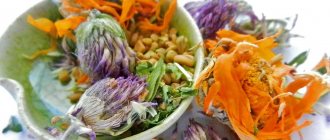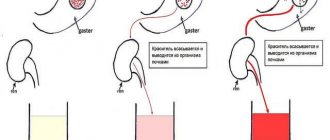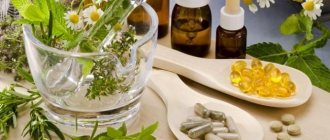How to cure adenomyosis with traditional medicine recipes
Adenomyosis is a pathological condition of the uterus in which there is excessive growth of its inner mucous membrane (endometrium). This disease often causes prolonged uterine bleeding and pain in the lower abdomen. Many people with adenomyosis experience spotting or menstrual irregularities.
An inflammatory process develops in the uterine cavity, and its size increases. It is not always possible to determine the exact cause of adenomyosis. Most often called a hereditary factor. The development of the disease can also be caused by: surgical intervention in the uterine cavity, excessive exposure to the sun or in a solarium, and frequent changes in climate zones.
Treatment of uterine adenomyosis with folk remedies
This disease is treated depending on the stage: conservative or surgical. However, at the initial stage, you can overcome the disease by using traditional medicine recipes. They usually include medicinal herbs that have high healing powers. What are these folk remedies for adenomyosis that will help improve the endometrium? Read more here.
Collections of medicinal herbs
Treatment with such herbs stabilizes hormonal levels well, eliminates congestion in the pelvis, and inhibits the growth of the endometrium and endometrioid cysts. For this, infusions are prepared from two collections:
- The first includes herbs: plantain leaves, celandine, poplar buds, birch buds and leaves, juniper cones and calamus root. Add one teaspoon of herbal mixture to 240 milliliters of hot water. After this, the infusion is allowed to brew. Then filter through a layer of gauze. Take the infusion only during the period of ovulation (usually from 4 to 8 days). (This can be determined using the "calendar method", the "basal temperature method" or using ultrasound.) During the day, the infusion is drunk. Take 60 milliliters at a time. Also during this period, take a tincture of peony roots: 45 drops in the morning and evening.
- The second collection includes: sage, currant and eucalyptus leaves, clover cones, stems, seeds and roots of anise, fireweed flowers and licorice root. Everything is taken in equal parts and crushed. An infusion is prepared and used in the same way as in the first case, but only during menstrual bleeding. Course of treatment: must be at least 9 cycles. During this treatment, tincture of Eleutherococcus is taken twice a day. Dosage per dose: 30 drops.
Medicinal plants
1. For adenomyosis, a plant is also used - wintergreen. An infusion is prepared from it. Take 30 grams of dry leaves. This is the norm for 300 ml of boiling water. Leave in a warm place or thermos for at least two hours. Next, filter, the entire infusion is divided into four servings and drunk throughout the day.
2. An infusion of wintergreen will also have an anti-inflammatory, analgesic and absorbable effect on the endometrium of the uterus. A teaspoon of herbs is brewed with a cup of hot boiling water and infused. It is advisable to do this in a thermos. Time: about two hours. Take 100 milliliters three times a day.
3. For medicinal purposes in case of illness, you can use a plant - the root of the red brush. One tablespoon of crushed raw materials is poured into 250 ml of boiling water. Steam in a water bath for 20 minutes. Take the finished product three times a day, 60 milliliters. After taking the decoction, you should pause for 30 minutes before eating. Treatment is recommended for one month.
4. Good reviews from former patients were left about the effective treatment of the disease with such medicinal herbs. They take: shepherd's purse, calamus root, swordtail and white cinquefoil, knotweed and nettle herbs. Mix everything and separate two tablespoons, which are poured with 500 milliliters of hot boiling water. Leave the infusion covered for two hours. The finished product is divided into three doses. Treatment is carried out for at least three weeks. After a week's break, the course is continued.
Adenomyosis is a disease, the essence of which is excessive growth of the inner layer of the uterus (endometrium), which provokes pain during menstruation and a high likelihood of infertility. The symptoms of this disease are nonspecific, so only an obstetrician-gynecologist can detect the disease after a thorough examination.
The specialist begins treatment only after the true cause of the pathology has been established - hormonal imbalance, inflammatory processes. Often, herbal medicines based on plants become part of the therapeutic regimen: cinquefoil, hogweed, birch, and sage. Their use has a positive effect on a woman’s hormonal balance and also neutralizes inflammatory reactions.
Douching for uterine adenomyosis
Another effective method of treating the disease is douching with medicinal herbs. This procedure helps to have a direct effect on the diseased area of the mucous membrane. To prepare the product, a mixture of medicinal cultures is used, the properties of which improve the overall effect of therapy.
For all decoctions, only dry and crushed herbs are used, which are purchased in official pharmacies. Take a pinch of herbs in equal proportions and pour a glass of boiling water. Leave in a thermos for several hours, then filter.
The following crops can be used for douching: eucalyptus leaves, calendula flowers, dried flowers, peony, mistletoe, celandine, bergenia, oak root, celandine, yarrow, nettle leaves.
Douching is carried out once a day, most often before going to bed. The duration of treatment should not exceed 30 days, otherwise there is a high risk of disturbing the acidity in the vagina, which will lead to bacterial imbalance. Your doctor will help you determine the correct treatment.
How to treat uterine adenomyosis with folk remedies
Adenomyosis is a disease often diagnosed among women over 40 years of age who gave birth to a child at a late age. It is often detected simultaneously with endometriosis. Before planning a pregnancy, it is worth carrying out therapy. It is necessary to know how adenomyosis is treated with folk remedies in order to defeat the pathology without the use of chemicals.
Causes of adenomyosis
The diagnosis of adenomyosis means a disease of the uterus in which pathological growth of the inner layer of the mucous membrane - the endometrium - occurs. Research into pathology for more than 100 years has not provided a comprehensive answer to the question of why it develops.
Adenomyosis is one of the little-studied gynecological diseases. There are several hypotheses regarding its etiology. Some doctors claim that the cause of pain is sexually transmitted infections or previous interventions. Injuries to the cervix can provoke an inflammatory process inside the organ. Changes in hormonal levels also affect a woman’s condition.
Symptoms
Sometimes the symptoms of the disease with adenomyosis are completely absent. The woman attributes all possible manifestations of the disease to individual characteristics or hormonal imbalance.
In practice, pathology can manifest itself through the following symptoms:
- menstrual irregularities;
- the appearance of bleeding between periods;
- enlarged uterus on ultrasound;
- pain syndrome on the eve of or after menstruation;
- long menstruation;
- pain on palpation of the uterus.
Often women do not seek to treat painful menstruation, considering it part of the norm. However, a timely visit to a gynecologist will allow you to quickly cure adenomyosis at an early stage, using simple folk remedies.
Adenomyosis and endometriosis should not be confused, so we recommend further studying the symptoms of these diseases.
Factors provoking adenomyosis
Although the exact causes of adenomyosis are unknown, long-term studies have helped identify a number of factors that can trigger the onset of the pathology. The increased risk of developing the disease is influenced by:
- history of childbirth, abortion or curettage;
- chronic inflammatory processes of the genital tract;
- cell metaplasia;
- hormonal disorders;
- improper production of estrogen;
- low immunity;
- life in constant stress;
- unfavorable genetic predisposition;
- previous operations;
- tanning abuse;
- frequent moves to different climatic zones;
- inactive sex life.
The risk of developing this disease increases in the presence of other gynecological diseases, for example, fibroids in combination with adenomyosis. After diagnosing uterine pathologies, including adenomyosis, the doctor may recommend using a boron uterus.
Herbal medicine against adenomyosis
Treatment of adenomyosis with herbs is one of the most effective means in the fight against pathology. To achieve improvements, infusions must be used regularly, strictly following the recommended dosage.
Most medications should not be stopped even during menstruation.
The most effective herbs for women
Well-formulated herbal teas are an excellent remedy for combating adenomyosis. The course of treatment is determined individually, based on the stage of development of the disease and the symptoms that appear.
Properly selected herbs can have the following effects:
- relieve inflammation;
- stop the bleeding;
- reduce pain syndrome;
- stabilize the rate of monthly growth of the endometrium.
From women who got rid of gynecological diseases through the use of folk remedies, you can hear about the effectiveness of serpentine, cinquefoil, knotweed, cinquefoil, calamus root and many other herbs. To achieve the effect, it is important to properly prepare and apply medicinal formulations.
Borovaya uterus in the treatment of adenomyosis
Borovaya uterus for adenomyosis is a proven effective remedy. The plant can relieve pain, reduce inflammation and prevent unlimited growth of the endometrium. A full course of treatment allows you to normalize hormonal levels and the frequency of the menstrual cycle.
To prepare a medicinal product, it is recommended to use the flowers of the plant. The tincture is taken orally. You can prepare it in several ways. There are alcohol compositions or products during the preparation of which the flowers are poured with boiling water.
The alcohol infusion is made as follows:
- 100 g of raw materials pour 0.5 liters of vodka;
- leave for 30 days;
- Strain the solution and squeeze out the grass.
Take the product twice a day, 25 drops, previously diluted in a small amount of water. The duration of treatment for adenomyosis is about 3 weeks, after which a month's break is taken, and then the therapy is repeated.
Medicines prepared without the use of alcohol are often intended for douching. During therapy, it is better to combine external treatment and oral medications. To make a mixture for vaginal use, you need to pour boiling water over a spoonful of raw materials, leave and strain. To increase the effectiveness of the product, it can be boiled over low heat for 5-7 minutes.
After preparation, the composition is infused for an hour, and then douching is carried out. Greater results can be achieved when performing the procedure at night.
Nettle and plantain in the treatment of adenomyosis
The decoction is taken to stop uterine bleeding. Both plants are able to activate tissue regeneration.
Herbs can be combined or taken separately. The nettle is dried and two tablespoons of raw material are taken. The mixture is poured into a glass of water brought to a boil. The composition should be drunk a quarter glass up to five times a day. A similarly prepared plantain decoction is taken 3-4 times a day.
Sabelnik in the treatment of adenomyosis
This folk remedy is no less effective for the treatment of gynecological pathology. The use of a decoction is justified in order to eliminate inflammation. A long course has an antitumor effect.
Review of popular traditional medicine
There are several areas of alternative medicine:
- Herbal medicine – treatment with medicinal herbs;
- Hirudotherapy – the use of medicinal leeches;
- Alternative physiotherapy – treatment with mud and other natural ingredients outside registered resorts and hospitals;
- Homeopathy is the use of highly diluted medicines to treat diseases.
It is also useful to read: Use of the Mirena spiral for uterine adenomyosis
Let's take a closer look at the most popular methods of treating adenomyosis and find out whether they are effective.
Phytotherapy
The most effective herbs are traditionally considered to be hogweed and red brush. These herbs are called feminine herbs. Traditional healers prescribe boron uterus and red brush for any gynecological diseases. It is believed that they remove fibroids, suppress the growth of endometriosis foci, restore the mucous membrane of endometrial hyperplasia, resolve cysts and eliminate true tumors. If you believe reviews on the Internet, “female” herbs can cope with ovarian cancer.
Gynecologists are not so positive about herbal medicine. These herbs actually have a beneficial effect on a woman’s hormonal levels, but their effect is rather weak. There is no reliable evidence that herbal medicine promotes the regression of foci of adenomyosis and prevents the progression of the disease. The universal effect of these herbs has not been proven. The substances included in their composition cannot simultaneously influence different parts of the pathogenesis of gynecological diseases: tissue proliferation, the inflammatory process, the formation of cystic cavities, etc.
Borovaya uterus and Red brush are popularly considered “female herbs” that help treat diseases of the reproductive system.
Important aspects of herbal medicine:
- Medicinal herbs do not inhibit cell growth. They are ineffective against endometriosis;
- The effect of herbal remedies can be felt after 1-3 months. You should not expect a quick effect. Traditional healers recommend drinking herbs for at least 6 months;
- The absence of symptoms during herbal treatment does not mean that the disease has completely gone away and will not return;
- Many herbs cause allergic reactions;
- Some herbal medicines are prohibited during pregnancy and lactation, in adolescents, people with pathologies of the digestive tract and kidneys;
- Phytoestrogens contained in “female” herbs can lead to the growth of endometriosis. It is impossible to predict their effect on a woman’s body.
Herbal remedies used in the treatment of adenomyosis:
- The hogweed and the red brush enhance each other's effects and are used together. Contains phytoestrogens, which affect a woman’s hormonal levels;
- Sea buckthorn and flax. Vegetable oils accelerate tissue healing. They are ineffective against adenomyosis, since the product cannot be applied to the lesion. Can be used in tampons to stimulate local immunity, including after surgery;
Sea buckthorn and flaxseed oils promote wound healing.
- Beets and carrots. To treat adenomyosis, traditional healers suggest applying compresses with beet or carrot juice to the stomach. It is not clear how plant materials should get to the uterus. Vegetable juice does not pass through the skin;
- Wormwood, mantle and nettle. The juice of these plants stimulates the immune system and reduces blood loss. It is recommended to take a decoction or infusion daily until the condition improves. Such treatment is justified only for moderate symptoms of the disease. Full uterine bleeding cannot be stopped with wormwood and nettle;
- Burdock. The juice of this plant is considered a miracle cure for all diseases. Traditional healers emphasize that burdock activates the body's own resources and directs them to fight the disease. How this plant affects the course of adenomyosis is not known;
- Viburnum and oak bark. These plants contain vitamin K, which enhances blood clotting. Viburnum and oak bark is used as a hemostatic agent for heavy menstruation. Ineffective for severe bleeding;
- St. John's wort. Strong natural immunomodulator. Activates the body's defenses, increases overall tone. It is not prescribed together with COCs. St. John's wort reduces the effectiveness of combined oral contraceptives and may lead to unwanted pregnancy;
- Sabelnik. The marsh plant has wound-healing, anti-inflammatory, and hemostatic properties. Facilitates the course of the disease, relieves unpleasant symptoms;
- Celandine. Natural pain reliever. Facilitates menstruation, eliminates discomfort;
- Vitex sacred. Relieves pain during menstruation, improves mood, increases overall tone;
Vitex sacred helps fight pain during menstruation.
- Wintergreen. Has a weak anti-inflammatory effect. Can be used for menstrual pain;
- Turmeric and ginger. Spices are considered antiseptics and immunomodulators. Stimulates the body's defenses.
Non-hormonal treatment for adenomyosis relieves symptoms, but works slowly. For quick results, you should turn to traditional methods of therapy.
Medicinal herbs can be taken in various ways:
- Decoction. Dry grass (volume is determined individually) pour boiling water (0.5-1 liter). Some recipes additionally recommend boiling the broth for 5-15 minutes. Take the finished product chilled;
- Infusion. Pour boiling water over dry raw materials. Leave for several hours or days in a dry, dark place. Take chilled;
- Tincture. The herb is infused in alcohol for several days. Take in small quantities (10-20 drops);
- Solutions for external use. Pour dry raw materials with water in the required proportion, cool to a comfortable temperature. Use for washing or douching;
- Bath solution. Add the prepared decoction of herbs to a bath of water (35-37 degrees). Sitz baths will be beneficial;
- Tampons. You can prepare it yourself from plant materials and gauze or purchase ready-made phytotampons. Insert deeply into the vagina and wait at least 3 hours. Remove if discomfort occurs. You can use phytotampons overnight;
- Compresses. Moisten a cloth with plant material and apply it to the affected area. It is assumed that the juice of the plant should penetrate the skin to the uterus and cure adenomyosis. This is physically impossible, so such treatment is highly doubtful.
Medicinal herbs are used in various ways. The photo shows the release forms of the hog uterus.
In the treatment of endometriosis, the use of bee products is practiced. Honey, bee bread, and propolis are used in the form of tampons, lotions, and ointments. Such products are added to decoctions and infusions of herbs. The immunostimulating effect of honey and propolis is known, but their effect on the course of adenomyosis has not been studied.
It is also useful to read: Internal endometriosis (adenomyosis)
Hirudotherapy
Treatment with leeches is an old way of getting rid of all diseases. Two centuries ago, bloodletting was popular. It was assumed that this tactic alleviates the patient’s condition with cardiovascular diseases. Hirudotherapy was also practiced, in which leeches not only draw blood, but also inject substances that thin it.
Medical leech is included in the Register of Medicines, but you should not expect miraculous healing after hirudotherapy. Place leeches in the vagina, where they are attached for 10-15 minutes. Leech thins the blood, but does not affect the course of adenomyosis. There is a slight improvement in blood flow in the pelvic organs. Foci of endometriosis do not decrease during treatment.
Leeches are used to improve blood flow in the pelvic organs, but they do not have a significant effect on foci of adenomyosis.
Homeopathy
If you believe numerous reviews, homeopathic medicines can cope with almost any disease without harming the body. It is assumed that with the correct selection, it is possible to remove foci of adenomyosis, eliminate bleeding, achieve the disappearance of pain and forget about the disease forever. There are no side effects with this treatment, which makes homeopathy especially attractive among elderly patients.
Classical medicine specialists do not share a positive attitude towards homeopathy. There is no reliable evidence that drugs in low dilutions affect the course of adenomyosis. The absence of side effects is explained by the fact that homeopathic remedies do not contain active substances. The effect of homeopathy is comparable to placebo.
Physiotherapy
In modern gynecology, physiotherapeutic agents are practically not used to treat adenomyosis. Clinical studies have shown that their effectiveness is negligible. Similar methods can be used in complex therapy of the disease, including after surgery.
Traditional healers suggest using mud and turpentine baths to treat endometriosis. Covering the stomach with clay is practiced. The effect of such methods on a woman’s body has not been studied. It is assumed that physical therapy improves blood flow in the pelvic organs, eliminates premenstrual syndrome and relieves pain, but does not affect the growth of endometriotic lesions.
It is believed that smearing the abdomen with healing mud, in particular clay, improves blood supply to the pelvic organs. However, in practice, this is not able to influence the foci of endometriosis themselves.
Other treatments
Alternative medicine offers various prescriptions against adenomyosis:
- ASD-2 fraction, registered in veterinary medicine, is used to treat human diseases. According to traditional healers, this substance has a powerful immunostimulating effect and helps the body cope with the disease on its own;
- Shilajit is considered a universal remedy for all diseases. It is unknown how this substance affects the course of adenomyosis and whether it can cope with the symptoms of the disease. Traditional healers indicate that mumiyo resolves adhesions, suppresses the growth of new lesions and stops bleeding;
- Ayurveda suggests preventing hypothermia in the legs and lower back in case of adenomyosis. According to supporters of this theory, endometriosis occurs when kapha (cold and dampness) accumulates in the reproductive organs;
- Treatment of adenomyosis with vitamins is not widespread. Taking vitamin C and B9 will benefit a woman, especially when planning pregnancy, but will not cure the disease.
Adenomyosis is not a disease that can be cured with folk remedies. While the woman drinks herbal infusions and applies leeches, the disease progresses. Severe pain and bleeding inevitably bring the patient to the operating table. You should not delay your visit to the doctor, relying on alternative medicine. With timely and adequate therapy, the development of complications can be avoided and radical intervention can be avoided.
Interesting video about endometriosis: prevention and treatment of pathology
Hirudotherapy in the treatment of gynecological diseases: a specialist says
Prevention and prohibited drugs
Since the causes of the disease are not known exactly, there is no specific prevention. You can reduce the risk of the disease if you eat right during adenomyosis, have an active sex life, and periodically visit a female doctor. It is important to follow these recommendations:
- spend less time in the open sun;
- do not overexert yourself with physical activity;
- do not visit solariums.
Adenomyosis should not be treated using heat. It is important to avoid visiting saunas and baths. It is impossible to carry out a warming massage of the lower back. You should exclude coffee, alcoholic drinks and any foods that contribute to weight gain from your diet.
Properly designed folk treatment will help cope with the pathology. The earlier therapy is started, the more effective it will be. Periodic visits to the gynecologist will help identify the disease in the early stages.
The essence of pathology
Uterine adenomyosis is a pathology of the endometrium, the lining layer of the organ. Endometrial cells begin to grow into other uterine layers, multiply outside the organ, and can affect the bladder, ovaries, and digestive organs.
These cells obey all hormonal processes and function cyclically, in accordance with menstruation. In turn, such activity provokes local inflammatory processes in the affected organs.
The muscular layer of the uterus is also included in the process - it is one of the first to take the blow. With the development of pathology, the organ is affected diffusely or locally.
The nodular form occurs in one place; with diffuse lesions, foci of adenomyosis can be diagnosed everywhere. Depending on the degree of damage to the uterus, degrees of pathology are distinguished.
Adenomyosis itself is not a dangerous disease. Endometrial cells, even after growing in other organs, retain their genetic structure and do not degenerate into malignant ones.
However, constant inflammatory processes provoke a decrease in immunity in patients, so the risk of oncology increases. With adenomyosis, timely assistance is extremely important, and not only with traditional forms of therapy.
If a patient is diagnosed with uterine adenomyosis, treatment with folk remedies will be no less beneficial than drug therapy.
Can it be cured with folk remedies?
The use of traditional medicine as a separate and independent treatment will be less effective than complex treatment.
Therefore, doctors recommend using alternative medicine as additional measures to the main traditional treatment of pathology.
Pathology can be of the following types:
According to the degree of penetration into the muscle layer, the pathological focus can be observed:
- 1st degree - under the mucous membrane;
- 2nd degree - in the middle of the genital organ;
- 3rd degree - damage to the entire muscle layer;
- 4th degree - involvement of neighboring organs in the pathological process.
Of course, treatment with folk remedies will be more effective only in the initial stages of adenomyosis, and the deeper the process spreads into the tissue, the less opportunity there is to cure the disease with non-traditional means.
Advanced stages are not amenable to traditional conservative medicine, and their treatment is only surgical.
Causes
Pathology can occur for a number of the following reasons:
- heredity, the presence of endometriosis in female relatives;
- pathological onset of menstruation;
- excess weight;
- early sexual life;
- various manipulations in the uterus associated with high trauma;
- the use of intrauterine devices as a means of contraception;
- inflammatory pathologies of the female genital organs;
- dysfunctional bleeding;
- severe immune system disorders;
- low level of physical activity.
According to research, each of these reasons is a risk factor or a direct trigger for the development of pathology, so women need to take this into account to protect themselves from adenomyosis.
General treatment recommendations
For adenomyosis, two treatment options are possible:
- conservative therapy;
- operation.
Drug treatment consists of taking medications aimed at normalizing hormonal levels and immune system functions. The purpose of surgery is to restore the normal anatomical structure of the female genital organs, as well as to remove all foci of inflammation.
Adenomyosis cannot be completely cured unless a hysterectomy (removal of the uterus) is performed. When the organ is preserved, the pathology tends to re-develop. Independent regression begins after menopause.
Since the disease regresses after menopause, gonadotropin-releasing hormone agonists (Zoladex, Diferelin, Buserelin, etc.) are prescribed. They create a reversible effect of menopause, which causes regression of the pathological process.
We recommend reading: Balanoposthitis: causes, symptoms, diagnosis and treatment methods
Hormonal contraceptives are used to prevent relapses. For the greatest effect, adhere to a prolonged regimen: three packs of the product in a row, followed by a seven-day break. It is also recommended to install an intrauterine device, against the background of which menstruation becomes scanty.
Symptoms
Among a number of signs, the main one for adenomyosis is the duration of menstruation. Women suffering from the disease complain of abnormal bleeding, which can last much longer than usual.
The consequence of large volumes of blood loss is secondary iron deficiency anemia. It gives more obvious physical symptoms indicating health problems. Such signs of pathology include:
- pale skin;
- loss of appetite;
- drowsiness;
- weakness;
- decline in working capacity;
- dizziness;
- dyspnea;
- decreased immunity;
- metrorrhagia;
- soreness a few days before and after menstruation.
These symptoms and treatment with folk remedies are quite compatible if you start therapy immediately after the diagnosis is made.
Possible causes and characteristic symptoms
Adenomyosis is most often diagnosed in women over 30 years of age. Since the disease is associated with the growth of the endometrium into the muscular layer, it is also called “adenomyosis of the uterine body.” Particles of the mucous layer sometimes enter neighboring organs and begin to grow there, as a result of which the homeostasis of the entire body is disrupted.
In most cases, the mucous membrane remains within the muscular layer and becomes the cause of other gynecological diseases. A woman’s hormonal levels are disrupted, immunity decreases, and swelling appears in the area where the endometrium grows. If mucous particles enter the vagina or cervical canal, cervical adenomyosis develops.
The exact causes of the pathology are not fully understood. Presumably, the appearance of adenomyosis is caused by factors that disrupt the barrier between the mucous and muscular layers of the uterus:
- curettage of the uterine cavity, abortion;
- C-section;
- excision of fibroid nodes (especially when opening the uterine cavity);
- delivery;
- inflammatory processes in the uterus (endometritis);
- other gynecological operations.
Adenomyosis can also be found in women who have never undergone surgery, have never had an abortion and do not have any inflammatory diseases, but this is extremely rare.
The disease in some cases affects young girls who have just started menstruating. Violation occurs for two reasons:
- abnormal intrauterine development, in which the mucous membrane, without the influence of any exogenous factors, grows into the uterine wall;
- insufficient opening of the cervical canal during menstruation (uterine contractions during menstruation in the presence of cervical spasm exert high pressure in the organ cavity, resulting in injury to the endometrium).
The main cause of adenomyosis in young women is due to “residual” endometrium that is not completely excreted with menstrual flow. The remaining particles become woven into the muscle layer, increase in volume and cause inflammation.
There is also a hereditary factor in the mechanism of development of the disease. The likelihood of pathology occurring is higher in women whose close relatives have suffered or are suffering from a similar illness.
We recommend reading: Endometriosis: causes, symptoms, treatment at home
Other provoking factors include:
- frequent stress;
- chronic insomnia;
- overwork;
- visiting solariums;
- unsystematic mud baths;
- excess consumption of salts and minerals.
A typical sign of the pathology is heavy, prolonged periods, as a result of which secondary iron deficiency anemia develops.
Herbal remedies and medicines have proven themselves in the treatment of uterine fibroids at home.
Thrush can be treated with folk remedies. Read more here.
Many traditional medicine recipes, which are described in this article, are effective in the treatment of genital herpes.
Symptoms of anemia:
- weakness;
- drowsiness;
- anemic skin (pallor);
- susceptibility to infections;
- shortness of breath with minor exertion (in severe cases);
- dizziness;
- decreased performance.
Adenomyosis typically appears a few days before menstruation or after discharge. In the middle of the cycle, uterine bleeding may occur.
Another sign of pathology is premenstrual pain, which lasts for several days and disappears 2-3-4 days after the start of menstruation. The severity of pain depends on the location of the pathological process. The most intense pain is observed when the isthmus of the uterus is damaged, as well as if an adhesive process additionally occurs. Pain is also observed during sexual intercourse, especially before menstruation.
Adenomyosis can accompany such a rare pathology as an accessory uterine horn. In this case, blood is thrown into the pelvic cavity, resulting in symptoms similar to those of an acute abdomen. The pain radiates to the groin area, rectum or vagina.
In general, the severity of symptoms depends on the stage and duration of the disease, the extent of the pathological process and the presence of other gynecological diseases.











